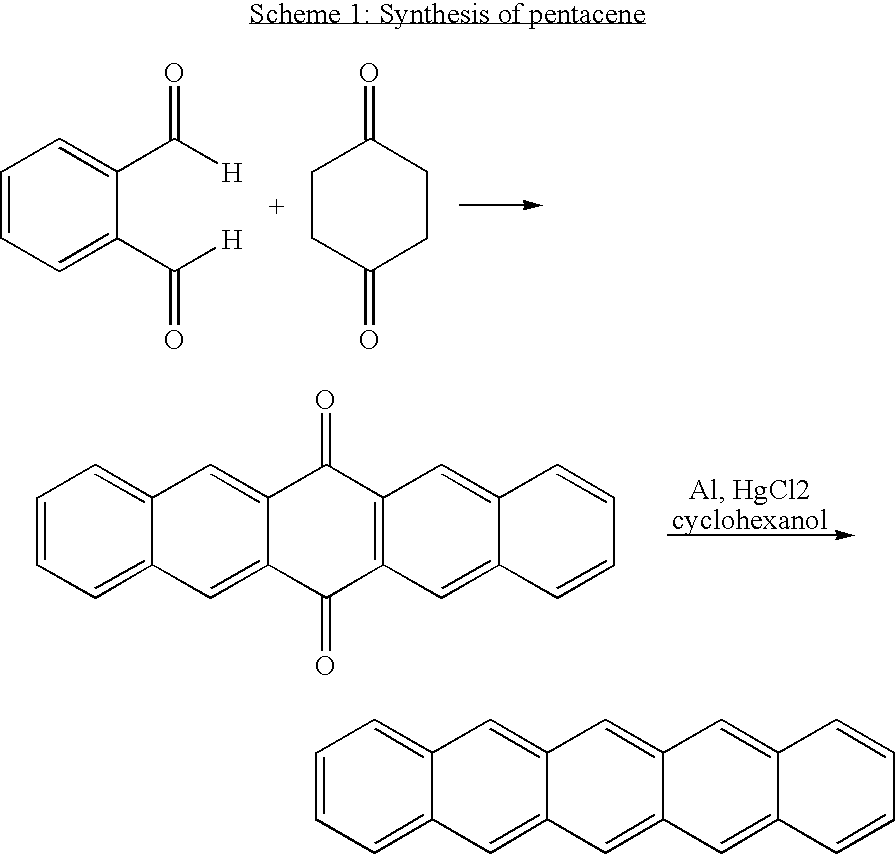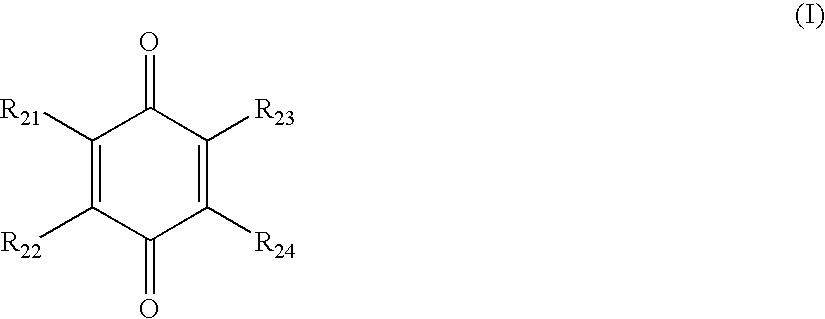Compounds comprising a linear series of five fused carbon rings, and preparation thereof
a technology of fused carbon rings and compounds, applied in the field of pentacene compounds, can solve the problems of preventing solution-based processing, requiring expensive equipment and long pump-down cycles, and polymorphic natur
- Summary
- Abstract
- Description
- Claims
- Application Information
AI Technical Summary
Benefits of technology
Problems solved by technology
Method used
Image
Examples
example 1a
Synthesis of Benzoquinone Adducts
[0319] Benzoquinone (0.040 g, 0.368 mmol) was dissolved in dry dimethylformamide (20 mL) and (3,4-bis(dibromomethyl)phenoxy)tert-butyl)dimethylsilane (0.407 g, 0.736 mmol, 2 eq.) was added, followed by Cu(OTf)2 (0.013 g, 0.037 mmol, 0.1 eq.) and NaI (0.717 g, 4.786 mmol, 13 eq.), respectively. The reaction was stirred at 65° C. for 8 hours. Once the absence of initial benzoquinone aliquot was confirmed by TLC, further aliquots of benzoquinone were added (0.010 g, 0.093 mmol, 0.25 eq., three further additions over the duration of reaction) until complete consumption of (3,4-bis(dibromomethyl)phenoxy)(tert-butyl)dimethylsilane was observed. Reaction was cooled to room temperature (22° C.) and the solution turned from brown to yellow upon the addition of cold sat. Na2S2O3. The yellow precipitate that formed was filtered and washed with H2O, then taken up with CH2Cl2 and concentrated. The impurities were dissolved in acetone and the product was filtered...
example 1b
Synthesis of Benzoquinone Adducts
[0320] 3,4-Bis(dibromomethyl)phenoxy)tert-butyl)dimethylsilane (1.10 g, 2 mmol) and benzoquinone (218 mg, 2 mmol) were added to ionic liquid 1-butyl-3-methylimidazolim iodide (5 g) under stirring. The mixture was heated to 60° C. for 2 h. The mixture was then washed with ether (4×), and the upper ether layer was decanted and combined. The ether was removed under reduced pressure and the solid was washed with acetone to afford 2.9 and 2,10-bis-(tert-butyl-dimethylsilyloxy)-pentacene-6,13-dione as a yellow solid (436.6 mg, 77%) The remaining ionic liquid phase was dried under vacuum and directly reused in the subsequent runs.
[0321] 2,9 isomer: mp: >270° C.; IR (solution cell: CH2Cl2): ν=3055, 3005, 1712, 1431, 1265, 1258, 1222, 909, 767, 756, 748, 729; 1H NMR (300 MHz, CDCl3) δ 8.83 (s, 2H), 8.73 (s, 2H), 7.98 (d, J=9 Hz, 2H), 7.41 (d, J=2.1 Hz, 2H), 7.27 (d, J=2.4 Hz, 1H), 1.02, (s, 9H), 0.29 (s, 6H); 13C NMR (75 MHz, CDCl3) δ 183.5 (C), 157.1 (C), ...
example 2
Synthesis of Bistriflates
[0322] 2,9 and 2,10-Bis-(tert-butyl-dimethylsilyloxy)-pentacene-6,13-dione (0.177 g, 0.312 mmol) were dissolved in THF (100 mL) and cooled to 0° C. A solution of tert-butylammonium fluoride in THF (1.0 M, 0.69 mL, 0.686 mmol, 2.2 eq.) was added and the reaction turned from yellow to deep blue. After 15 min., Tf2NPh (0.334 g, 0.936 mmol, 3 eq.) dissolved in THF (5 mL) was cannulated into the reaction flask and then warmed to rt (22° C.). The reaction turned from deep blue to red to yellow. After 24 h, the reaction was concentrated to 50 mL, diluted with ether, washed with 10% HCl, 5% NaHCO3 and H2O. Then it was concentrated to 20 mL and filtered through a sintered glass funnel to obtain the 2,9 and 2,10-Bis(trifluoromethylsulfonyl)pentacene-6,13-dione compounds (0.150 g, 80%) and used directly in the next step
PUM
| Property | Measurement | Unit |
|---|---|---|
| sub-threshold voltages | aaaaa | aaaaa |
| dielectric constant | aaaaa | aaaaa |
| dielectric constant | aaaaa | aaaaa |
Abstract
Description
Claims
Application Information
 Login to View More
Login to View More - R&D
- Intellectual Property
- Life Sciences
- Materials
- Tech Scout
- Unparalleled Data Quality
- Higher Quality Content
- 60% Fewer Hallucinations
Browse by: Latest US Patents, China's latest patents, Technical Efficacy Thesaurus, Application Domain, Technology Topic, Popular Technical Reports.
© 2025 PatSnap. All rights reserved.Legal|Privacy policy|Modern Slavery Act Transparency Statement|Sitemap|About US| Contact US: help@patsnap.com



